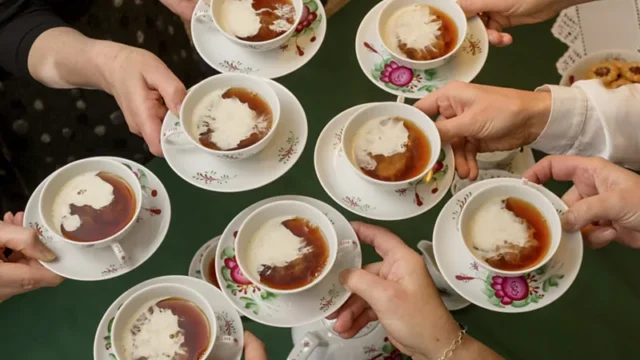Introduction: East Frisian tea
The world’s most prolific tea drinkers aren’t found in the UK or Ireland but in a lesser-known German region with a unique tradition. East Frisia, located in Germany‘s northwestern corner, boasts an impressive tea culture where locals consume more tea per capita than anywhere else.
East Frisia’s Record-Breaking Tea Consumption
In East Frisia, tea isn’t just a beverage; it’s a cultural cornerstone. According to Kyra Schaper of the German Tea and Herbal Infusions Association, East Frisians consume an average of 300 liters of tea per person annually, making them the world leaders in tea consumption. This record, certified by the German Records Institute in 2021, surpasses even the most renowned tea-drinking cultures globally.
The East Frisian Tea Ceremony
Celia Brandenburger, director of the local tea museum in Leer, explains that tea is more than just a drink; it’s a ceremony that engages all the senses. The traditional preparation begins with placing a piece of rock sugar, or Kluntje, at the bottom of a cup. As tea is poured, it creates a distinct crackling sound as it hits the sugar. Thick cream is then added in an anti-clockwise motion, creating a spectacle known as “Wulkje,” or small clouds, as the cream rises to the surface.
Experiencing the Tea Ceremony
The ceremony offers a unique tasting experience. The first sip is creamy, the second highlights the robust black tea, and the final sip is sweet from the dissolving rock sugar. This sequence is repeated as East Frisians traditionally enjoy three cups of tea at a time. The host continues to pour tea until a guest places a spoon in their cup, signaling they’ve had enough.

Where to Experience
Visitors can immerse themselves in the East Frisian tea tradition at local museums and tea houses:
- The Bünting Tea Museum in Leer: Offers insights into the history and culture of East Frisian tea.
- The East Frisian Tea Museum in Norden: Hosts traditional tea ceremonies and showcases the region’s tea heritage.
- Local Tea Houses: Experience traditional East Frisian tea in cozy settings, such as the East Frisian Tea Room at Leer’s harbor.
Tea as an Intangible Cultural Heritage
Tea drinking is deeply rooted in East Frisian culture, starting from a young age. The tradition was formally recognized in 2016 when it was inscribed as part of Germany’s intangible cultural heritage. Tea is omnipresent in daily life, from breakfast to bedtime, and serves as a symbol of regional identity.
Historical Significance
The tradition of tea drinking in East Frisia has evolved significantly over the centuries. Initially reserved for the wealthy in the 17th century, tea became more accessible in the mid-19th century with the British cultivation of tea in Assam, India. This accessibility, combined with a movement to strengthen regional identities, solidified tea as a cultural emblem of East Frisia.

Evolution of Tea Trade
The rise of major East Frisian tea trading companies in the 19th century played a crucial role in popularizing tea. Companies like Bünting, Thiele, and Onno Behrends established themselves, developing unique tea blends known as “genuine East Frisian blend.” Today, only tea blended in this region can bear this designation.
The Art of Tea Blending
At the Tea Association, tea taster Stefan Feldbusch ensures the quality of the region’s tea blends. His team samples various teas to maintain the signature strong, malty, and aromatic profile of East Frisian tea. The goal is to achieve a consistent taste, aroma, and color that meets the high standards of local tea enthusiasts.
Importance of Quality
It take pride in their tea’s quality. The perfect blend must produce a beautiful, bright color when combined with cream and rock sugar. This dedication to quality is a testament to the region’s deep connection to its tea tradition.
East Frisian Tea Culture Today
The tea culture continues to thrive, celebrated both locally and internationally. When King Charles and Queen Camilla visited Germany in 2023, the tea featured prominently on the menu at the state banquet in Berlin’s Bellevue Palace, showcasing the region’s unique tradition on a global stage.

Conclusion:
East Frisia, with its rich tea culture and record-breaking consumption, offers a unique glimpse into a lesser-known aspect of German heritage. For those looking to explore this hidden gem, a visit to its tea museums and houses provides an unforgettable experience of tradition, quality, and community.











